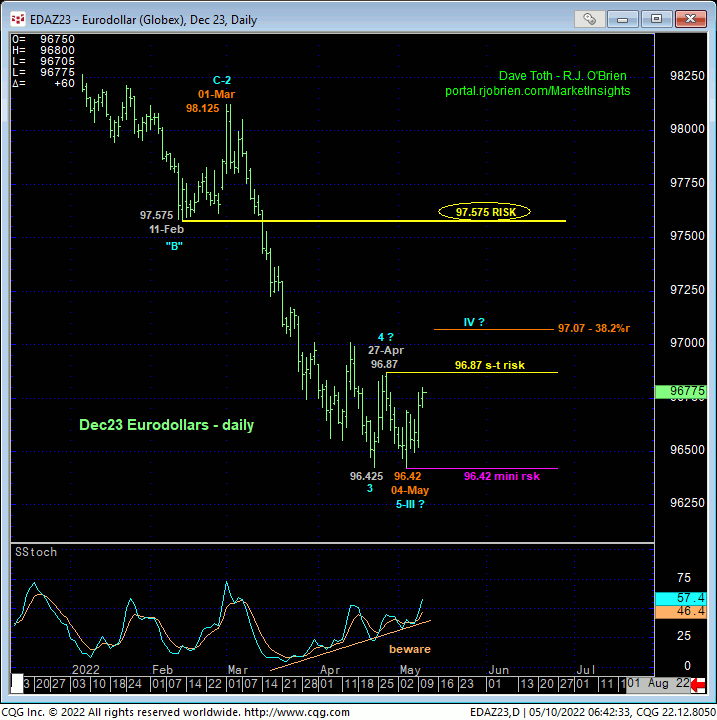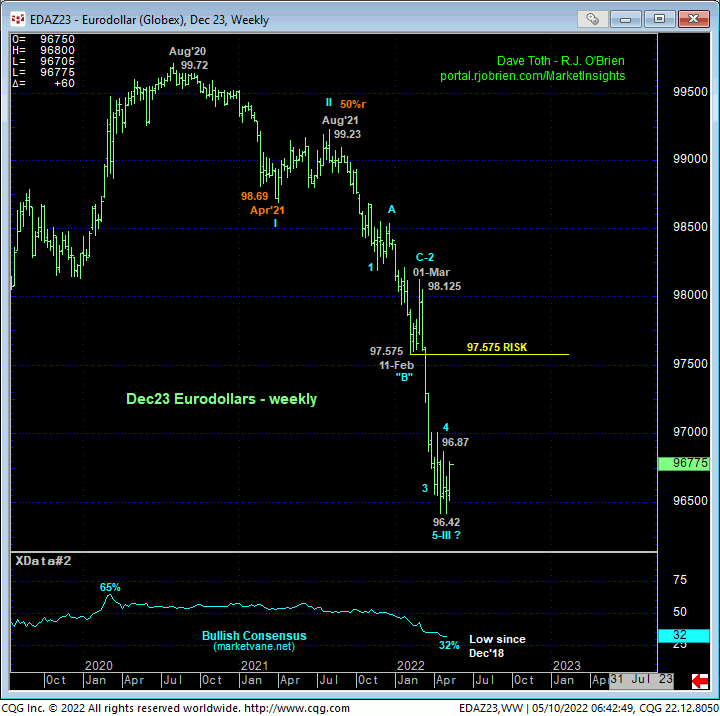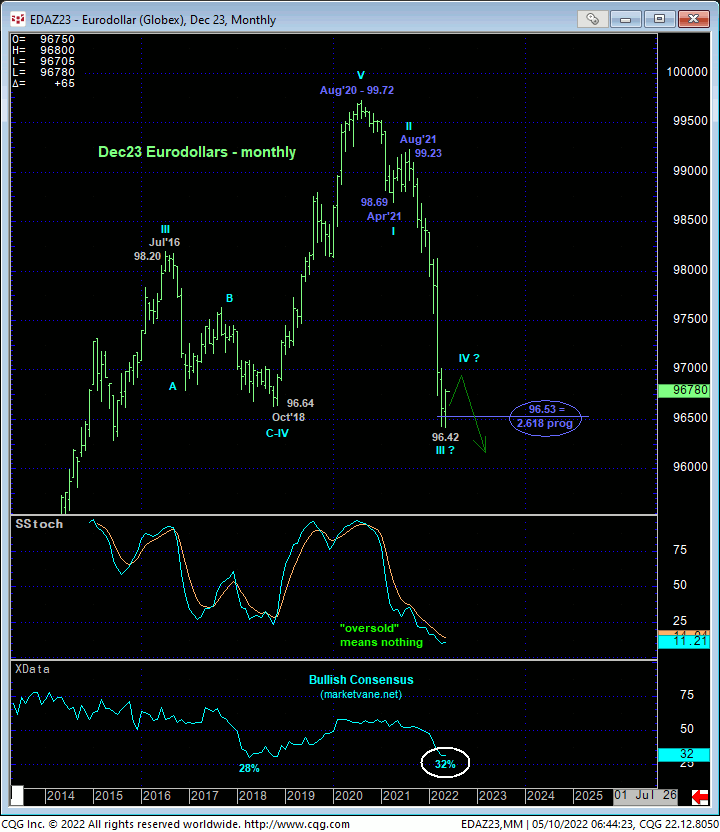
S-T Eurodollar Mo Failure Reinforces Interim Support
by Dave Toth
After breaking 22-Apr’s 96.425 low by a tick last week, the 240-min chart below shows that yesterday’s recovery above 04-May’s 96.69 initial counter-trend high confirms a bullish divergence in very short-term momentum. This mini mo failure defines last Wed’s 96.42 low as one of developing importance and a mini risk parameter from which shorter-term traders with tighter risk profiles can objectively base non-bearish decisions like short-covers and cautious bullish punts. This minor momentum failure now puts focus on 27-Apr’s 96.87 corrective high and our short-term risk parameter this market is required to recoup to confirm a bullish divergence in DAILY momentum that would prove the next level or scale of prospective strength.

Stepping back a bit, the daily chart below shows the nicely developing potential for a bullish divergence in DAILY momentum that, if confirmed above 27-Apr’s 96.87 corrective high, would arguably break the portion of the secular bear trend from 01-Mar’s 98.125 high, exposing a larger-degree correction of this portion of the bear. While a recovery above a relatively tight corrective high like 96.87 would be of a grossly insufficient scale to conclude anything more than a slightly larger-degree correction within the secular bear trend, even longer-term institutional players would be advised to at least pare bearish exposure to more conservative levels to reduce the risk of a corrective pop that could be nominally steep. Indeed, given a 2-month, 170-bp plunge, even a Fibonacci minimum 38.2% retrace of this 98.125 – 96.42 plunge doesn’t cut across until the 97.07-area.
To truly threaten the secular bear trend, commensurately larger-degree strength above at least former 97.575-area support-turned-resistance from mid-Feb remains required to jeopardize the impulsive integrity of the secular bear market. For those institutional players not wanting to incur the risk of bearish exposure to 97.575, the tightest viable and objective risk parameter is 96.87 that requires acknowledging and accepting whipsaw risk, back below 96.42, in exchange for steeper nominal risk above 97.575.


On an even broader scale, the weekly (above) and monthly (below) charts show the sheer magnitude of the major reversal from Aug’20’s 99.72 high that we’ve submitted may be generational in scope. The suspected 3rd-Wave meltdown from Aug’21’s 99.23 high eclipsed its (96.53) 2.618 progression of Aug’20 – Apr’21’s 1st-Wave decline from 99.72 to 98.69. This fact reinforces our long-term bearish count that suggests a least a 4th-wave correction and another round of (5th-Wave) lows thereafter is likely before a more considerable bottom might be established. The scope of such a 4th-Wave correction would be expected to be relatively minor but, given the magnitude of the plunge from Aug’21’s 99.23 high, potentially nominally steep. For institutional players looking to circumvent that risk, paring or neutralizing bearish exposure on further proof of strength above 96.87 is recommended. Long-term shorts can always be re-established after a bearish divergence in momentum arrests the recovery and rejects/defines a more reliable high from which to objectively do so.
Contributing to an intermediate-term corrective rebound IF the market confirms a bullish divergence in daily momentum above 96.87 is the understandably historic plunge to 32% in the Bullish Consensus (marketvane.net) measure of market sentiment/contrary opinion. This is the lowest level in this indicator since the Dec’18 period that warned of and accompanied the end of a more than 2-year correction and re-exposed the secular bull trend. This is a different situation to then as a new bear market is arguably underway. Nonetheless, technical discipline stipulates that the combination of a confirmed bullish divergence in mo and historically bearish sentiment exposes a counter-trend move that needs to be acknowledged and respected.
These issues considered, shorter-term traders with tighter risk profiles are advised to neutralize bearish exposure and move to a neutral/sideline position for the time being. A relapse below 96.42 negates this call and reinstates the secular bear, warranting a return to a bearish policy. Bearish exposure remains advised for longer-term players with a recovery above 96.87 required to defer our bearish count enough to warrant paring or neutralizing exposure in order to circumvent the heights unknown of an intermediate-term correction higher.


